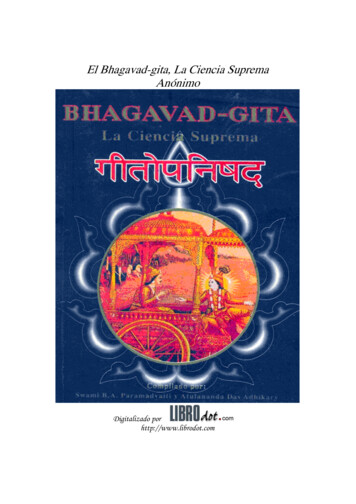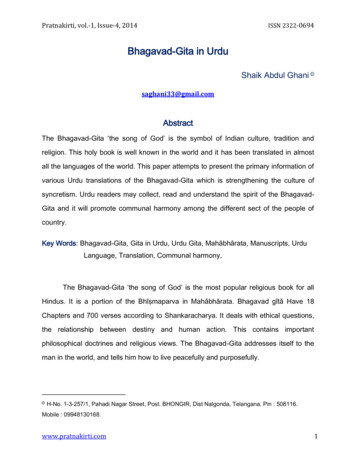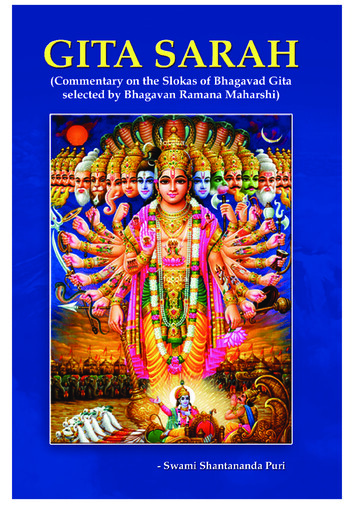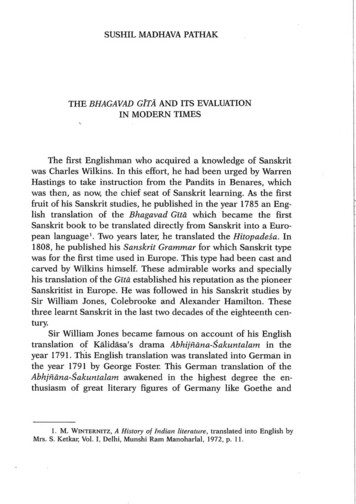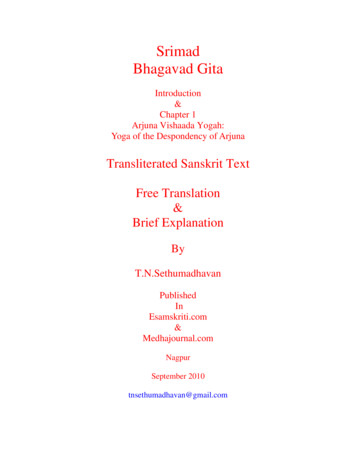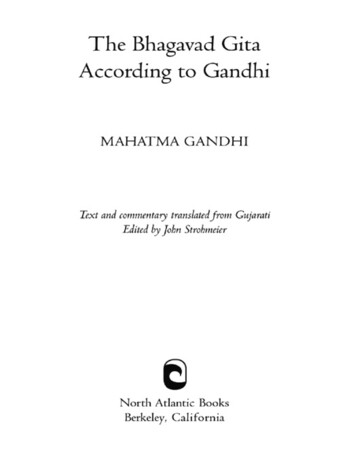
Transcription
ContentsForeword, by Michael NaglerEditor’s Note, by John StohmeierGandhi’s Text and CommentaryAbout the GitaEditing NotesAcknowledgmentsIntroduction, by Mahatma GandhiThe Bhagavad GitaChapter OneChapter TwoChapter ThreeChapter FourChapter FiveChapter SixChapter SevenChapter EightChapter NineChapter TenChapter ElevenChapter TwelveChapter ThirteenChapter Fourteen
Chapter FifteenChapter SixteenChapter SeventeenChapter EighteenBibliographyGlossaryEpithets of Krishna and ArjunaContributors
ForewordMICHAEL NAGLERTo write some words of introduction to this book is an honor I scarcelydeserve. Millions believe, myself among them, that Mahatma Gandhiwas the greatest human being to have walked through the turbulentpages of the twentieth century. And as for the Gita, its wisdom isunrivaled. As Julien Green says of the Christian Gospels in his biographyof St. Francis, “The book has a peculiar feature: You can listen to it yearafter year, and then a moment comes when from out of its pages comes asoundless, but deafening voice that you will never be able to silence.” Ihave had such moments reading the Gita, as have millions of others.It is important to grasp the relationship between this man and thisbook, this love-match between person and scripture. For Gandhi, theGita’s was a voice that changes forever the way one understands things,the source of a profound shift in behavior and vision. He describes, forexample, how he was once almost undone by worldly concerns when averse of the Gita—chapter two, verse 15—came to him, “and the verynext moment I was almost dancing with relief.”Such experiences do not come for the mere reading. Great as is thetruth of the Gita, or any scripture, the readiness is all. “The soil of ourmind has to be cultivated for the seed of the truth to take such hold.”That comment of Gandhi comes shortly before a section—the lasteighteen verses of the second chapter—on which he practicedmeditation nearly every day of his adult life. In his morning and eveningprayer meetings, Gandhi would use these verses to bring his mind to astandstill—a state of utmost receptivity to Truth. We might ascribe sucha reaction to faith, and that’s not wrong. But faith doesn’t comeunbidden, it requires systematic cultivation.In the modern era, there’s a tendency to think that this cultivation isintellectual. That would be true if the purpose were merely tounderstand the scripture. But for Gandhi, understanding was only anadjunct to self-realization, almost an unnecessary one. The point is not
just to understand, but to absorb, so that one unconsciously acts out thetruth absorbed. “At the back of my reading [of the Gita] there is theclaim of an endeavor to enforce the meaning in my own conduct for anunbroken period of forty years.” And he adds, quoting a proverb fromIndian tradition, “one may cast into the river a ton of thoughts and clingto an ounce of practice.”The good news is that no one lacks the endowment to find apractice. Intellectually we may not all be Einsteins, just as spiritually wemay not all be born, as my teacher, Sri Eknath Easwaran, used to say,“with a spiritual spoon in our mouth.” But what the Gita teaches (andGandhi unwaveringly did) is that by finding the right work and pluggingaway at it with determination, anyone can improve their capacity toabsorb Truth. From this teaching I draw no small comfort.If one wanted to pick the single hallmark of Gandhi’s behavior bywhich the sign of the Gita’s influence could be read, it would almostcertainly be desireless action. This requires a word of explanation. Whatone doesn’t desire in this state is not an opportunity to act, nor that hisor her action should do good. It’s phalam, usually translated the “fruit”of one’s action. This is literally correct, but more precisely it means thatresult which benefits us personally.Gandhi gives two superb illustrations of this elusive discriminationand why it is crucial that we make it. Is it wrong to be attached to apositive goal—say, to the one he was fighting for with every ounce of hislife’s strength? “Yes,” he answers, “[for] if we are attached to our goal ofwinning liberty, we shall not hesitate to adopt bad means.” Gandhi alsocollected millions of rupees from millions of individuals for the purposeof winning this goal, but, he maintained, “if a person is particular thathe would give coins to me personally,” either out of attachment toGandhi himself or out of a desire for recognition, “one day he mighteven steal them.” This subtle principle perhaps explains all of Gandhi, ifone knew how to apply it.I might give just one further illustration before stepping aside forthe reader to draw his or her own conclusions, and benefits, from thisremarkable book. One can be attached (in the negative sense) even tothe highest truth Gandhi espoused—nonviolence. Nonviolence canbecome a mood rather than a power, a congratulatory way one thinks
about oneself. When that happens, the belief in nonviolence is only that—a belief, not an opening of ourselves to the inner forces of Truth.Hence, Gandhi explained, we see the seemingly contradictory posture ofthe Gita’s Krishna, who urges the hero Arjuna, who represents you andme in his spiritual crisis and befuddlement, to fight while holding aloftthe banner of nondiscrimination and nonviolence. “Even if we believe innonviolence, it would not be proper for us to refuse, through cowardice,to protect the weak.” How do we know whether we’re refusing out ofcowardice or nonviolence? That only a lifetime of practice can help usdecide.
Editor’s NoteJOHN STROHMEIERGandhi’s Text and CommentaryThe Bhagavad Gita According to Gandhi is based upon talks given byMahatma Gandhi at Satyagraha Ashram in Ahmedabad, India betweenFebruary 24 and November 27, 1926. During this time—a period ofwithdrawal from mass political activity—Gandhi devoted much of hisenergy to translating the Gita from Sanskrit into his native Gujarati. Thiseffort inspired him to address his followers almost daily, after morningprayer sessions, about its content and meaning as it unfolded before him.Gandhi’s commentary was transcribed on the spot by hisamanuensis, Mahadev Desai, and at least one other resident of theashram, Punjabhai, but not until 1955 was it published in its entirety, inGujarati. It first appeared in English in The Collected Works of MahatmaGandhi, published by the Government of India in 1969. It is widelyregarded as among the most important commentaries on the Gitaproduced in India in the twentieth century, alongside those of B. G.Tilak, Sri Aurobindo, and Sarvepalli Radhakrishnan.For this edition, in an effort to bring forward and clarify the essenceof Gandhi’s thinking, I have abridged the commentary considerably, andrearranged it in a few sections. The original presentation of the materialwas unrehearsed and relatively spontaneous, and includes many of theredundancies, contradictions, ellipses, false starts, and situationaldigressions of everyday conversation. Some of these I have deleted afterpursuing the trail of Gandhi’s thought carefully and respectfully. (Amongthese deletions is one from chapter eight, lines 9–10, where Gandhiobserves that one who “keeps his mouth shut” attains to the realm of theSupreme; certainly a comment to the restless boys in his audience.)Others I have let stand where they illuminated important ideas, orexplained the context in which he made his remarks. For example, hisreferences to an impending flood, the killing of a snake, and the
tormenting of a dog by some boys, although quite specific to ashramevents, carry lessons that apply to the world beyond the ashram walls.About the GitaThe Bhagavad Gita, “The Song of the Lord,” is a 700-line section of amuch longer Sanskrit war epic, the Mahabharata. The Mahabharata tellsthe story of a legendary conflict between two branches of an Indianruling family that may have taken place between 1000 and 700 B.C.Authorship of the poem is traditionally ascribed to Vyasa, who perhapslived between the fifth and third centuries B.C.In the Mahabharata, Pandu, the King of Hastinapura, leaves histhrone and retires to the forest in a response to a curse, never to return.In his absence his elder brother, the blind Dhritirashtra, is to act asRegent, presumably until Pandu’s son, Yudhishthira, is old enough toassume the role of king. Over time, Dhritirashtra comes to prefer that hisown son, Duryodhana, become king in Yudhishthira’s place. The battlebetween Duryodhana and his followers (the Kauravas) and thesupporters of Yudhishthira (the Pandavas) for rule of Hastinapura setsthe scene for the Bhagavad Gita.Nearly the entire text of the Bhagavad Gita is a conversationbetween Krishna, an incarnation of the god Vishnu, and Arjuna,Yudhishthira’s brother and General of the Pandava army. Krishna isArjuna’s charioteer. Their conversation takes place in the middle of thebattlefield just as fighting is about to begin.The first few lines of the Gita can be somewhat confusing becausethe entire conversation between Krishna and Arjuna is presented asreported speech. The blind Regent Dhritirashtra asks his Prime Minister,Sanjaya, to describe for him the progress of the battle. Although they arefar from the battlefield, Sanjaya is granted the power of divine sight inorder that he might observe and relate to Dhritisrashtra the defeat of hissons.Editing Notes
The text and commentary presented here are taken almost entirely fromthe Collected Works of Mahatma Gandhi, volume XXXII (1926–27), pages94–376, “Discourses on the Gita.” The names of those who executed thetranslation from Gandhi’s Gujarati into English for the Collected Worksare not listed, although the translation of the text of the Gita itselffollows, with only slight variation, Mahadev Desai’s edition (seebibliography), which was proofed and authorized by Gandhi. Additionalcommentary on a few verses is taken from the very limited notes Gandhiinserted in Desai’s important work.A number of Sanskrit words, such as yajna, bhakti, and karma, aregenerally not translated because no satisfactory equivalents exist inEnglish. These words are printed in italics and defined in the glossary atthe back of the book, along with a list of epithets used for Krishna andArjuna. Note that parentheses in the text are, without exception,Gandhi’s notations, while the occasional clarifications and definitions Ihave inserted are set off by square brackets.AcknowledgmentsI would like to thank for their ideas and encouragement Robert Dobbin,Daniel Peckham, Laura Pérez, and Michael Nagler. I am also indebted tothe late Eknath Easwaran for his inspiration to explore the works ofMahatma Gandhi, and to those gifted editors who have producedprevious editions of Gandhi’s Gita writings: Mahadev Desai and NarahariParikh.
IntroductionMAHATMA GANDHIThis introduction was written in 1929 to accompany Gandhi’s Gujaratitranslation of the Bhagavad Gita. He later translated the essay into English,and published it in 1931 in the pages of his periodical, Young India, underthe title, Anasaktiyoga: The Gospel of Selfless Action.1. Just as, acted upon by the affection of coworkers like SwamiAnand and others, I wrote my [autobiography] Experiments with Truth, sohas it been regarding my rendering of the Gita. “We shall be able toappreciate your meaning of the message of the Gita, only when we areable to study a translation of the whole text by yourself, with theaddition of such notes as you may deem necessary. I do not think it isjust on your part to deduce ahimsa [nonviolence] from stray verses.”Thus spoke Swami Anand to me during the noncooperation days. I feltthe force of his remarks. I, therefore, told him that I would adopt hissuggestions when I got the time. Shortly afterwards I was imprisoned.During my incarceration I was able to study the Gita more fully. I wentthrough the Gujarati translation of the Lokamanya’s [B. G. Tilak’s] greatwork. He had kindly presented me with the Marathi original and thetranslations in Gujarati and Hindi, and had asked me, if I could nottackle the original, at least to go through the Gujarati translation. I hadnot been able to follow the advice outside the prison walls. But when Iwas imprisoned I read the Gujarati translation. This reading whetted myappetite for more and I glanced through several works on the Gita.2. My first acquaintance with the Gita began in 1888–89 with theverse translation by Sir Edwin Arnold known as The Song Celestial. Onreading it I felt a keen desire to read a Gujarati translation. And I read asmany translations as I could lay hold of. But all such reading can giveme no passport for presenting my own translation. Then again myknowledge of Sanskrit is limited; my knowledge of Gujarati too is in noway scholarly. How could I then dare present the public with my
translation?3. It has been my endeavor, as also that of some companions, toreduce to practice the teaching of the Gita as I understood it. The Gitahas become for us a spiritual reference book. I am aware that we everfail to act in perfect accord with the teaching. The failure is not due towant of effort, but is in spite of it. Even through the failures we seem tosee rays of hope. The accompanying rendering contains the meaning ofthe Gita message this little band is trying to enforce in daily conduct.4. Again this rendering is designed for women, the commercialclass, the so-called Sudras [the lowest of the four castes], and the like,who have little or no literary equipment, who have neither the time northe desire to read the Gita in the original, and yet who stand in need ofits support. In spite of my Gujarati being unscholarly, I must own tohaving the desire to leave to the Gujaratis, through the mother tongue,whatever knowledge I may possess. I do indeed wish that at a time whenliterary output of a questionable character is pouring in upon theGujaratis, they should have before them a rendering the majority canunderstand of a book that is regarded as unrivaled for its spiritual meritand so withstand the overwhelming flood of unclean literature.5. This desire does not mean any disrespect to the other renderings.They have their own place. But I am not aware of the claim made by thetranslators of enforcing their meaning of the Gita in their own lives. Atthe back of my reading there is the claim of an endeavor to enforce themeaning in my own conduct for an unbroken period of forty years. Forthis reason I do indeed harbor the wish that all Gujarati men or women,wishing to shape their conduct according to their faith, should digestand derive strength from the translation here presented.6. My coworkers, too, have worked at this translation. Myknowledge of Sanskrit being very limited, I should not have fullconfidence in my literal translation. To that extent, therefore, thetranslation has passed before the eyes of Vinoba, Kaka Kalelkar,Mahadev Desai and Kishorlal Mashruvala.Now about the message of the Gita7. Even in 1888–89, when I first became acquainted with the Gita, I
felt that it was not a historical work, but that, under the guise ofphysical warfare, it described the duel that perpetually went on in thehearts of mankind, and that physical warfare was brought in merely tomake the description of the internal duel more alluring. This preliminaryintuition became more confirmed on a closer study of religion and theGita. A study of the Mahabharata gave it added confirmation. I do notregard the Mahabharata as a historical work in the accepted sense. Byascribing to the chief actors superhuman or subhuman origins, the greatVyasa [author of the Mahabharata] made short work of the history ofkings and their peoples. The persons therein described may be historical,but the author of the Mahabharata has used them merely to drive homehis religious theme.8. The author of the Mahabharata has not established the necessityof physical warfare; on the contrary he has proved its futility. He hasmade the victors shed tears of sorrow and repentance, and has left themnothing but a legacy of miseries.9. In this great work the Gita is the crown. Its second chapter,instead of teaching the rules of physical warfare, tells us how a perfectedman is to be known. In the characteristics of the perfected man of theGita, I do not see any to correspond to physical warfare. Its whole designis inconsistent with the rules of conduct governing the relations betweenwarring parties.10. Krishna of the Gita is perfection and right knowledgepersonified; but the picture is imaginary. That does not mean thatKrishna, the adored of his people, never lived. But perfection isimagined. The idea of a perfect incarnation is an aftergrowth.11. In Hinduism, incarnation is ascribed to one who has performedsome extraordinary service of mankind. All embodied life is in reality anincarnation of God, but it is not usual to consider every living being anincarnation. Future generations pay this homage to one who, in his owngeneration, has been extraordinarily religious in his conduct. I can seenothing wrong in this procedure; it takes nothing from God’s greatness,and there is no violence done to Truth. There is an Urdu saying whichmeans, “Adam is not God but he is a spark of the Divine.” And thereforehe who is the most religiously behaved has most of the divine spark inhim. It is in accordance with this train of thought that Krishna enjoys, in
Hinduism, the status of the most perfect incarnation.12. This belief in incarnation is a testimony of man’s lofty spiritualambition. Man is not at peace with himself till he has become like untoGod. The endeavor to reach this state is supreme, the only ambitionworth having. And this is self-realization. This self-realization is thesubject of the Gita, as it is of all scriptures. But its author surely did notwrite it to establish that doctrine. The object of the Gita appears to me tobe that of showing the most excellent way to attain self-realization. Thatwhich is to be found, more or less clearly, spread out here and there inHindu religious books, has been brought out in the clearest possiblelanguage in the Gita even at the risk of repetition.13. That matchless remedy [i.e., the way to self-realization] isrenunciation of fruits of action.14. This is the center round which the Gita is woven. Thisrenunciation is the central sun round which devotion, knowledge, andthe rest revolve like planets. The body has been likened to a prison.There must be action where there is body. Not one embodied being isexempted from labor. And yet all religions proclaim that it is possible forman, by treating the body as the temple of God, to attain freedom. Everyaction is tainted, be it ever so trivial. How can the body be made thetemple of God? In other words how can one be free from action, i.e.,from the taint of sin? The Gita has answered the question in decisivelanguage: By desireless action; by renouncing fruits of action; bydedicating all activities to God, i.e., surrendering oneself to Him bodyand soul.15. But desirelessness or renunciation does not come for the meretalking about it. It is not attained by an intellectual feat. It is attainableonly by a constant heart-churn. Right knowledge is necessary forattaining renunciation. Learned men possess a knowledge of a kind.They may recite the Vedas from memory, yet they may be steeped inself-indulgence. In order that knowledge may not run riot, the author ofthe Gita has insisted on devotion accompanying it and has given it thefirst place. Knowledge without devotion will be like a misfire. Therefore,says the Gita, “Have devotion, and knowledge will follow.” Thisdevotion is not mere lip worship, it is a wrestling with death. Hence theGita’s assessment of the devotee’s qualities is similar to that of the sage’s.
16. Thus the devotion required by the Gita is no softheartedeffusiveness. It certainly is not blind faith. The devotion of the Gita hasthe least to do with externals. A devotee may use, if he likes, rosaries,forehead marks, make offerings, but these things are no test of hisdevotion. He is the devotee who is jealous of none, who is a fount ofmercy, who is without egotism, who is selfless, who is ever forgiving,who is always contented, whose resolutions are firm, who has dedicatedmind and soul to God, who causes no dread, who is not afraid of others,who is free from exultation, sorrow, and fear, who is pure, who is versedin action and yet remains unaffected by it, who renounces all fruit, goodor bad, who treats friend and foe alike, who is untouched by respect ordisrespect, who is not puffed up by praise, who does not go under whenpeople speak ill of him, who loves silence and solitude, who has adisciplined reason. Such devotion is inconsistent with the existence atthe same time of strong attachments.17. We thus see, that to be a real devotee is to realize oneself. Selfrealization is not something apart. One rupee can purchase us poison ornectar, but knowledge or devotion cannot buy us either salvation orbondage. These are not media of exchange. They are themselves thething we want. In other words, if the means and the end are notidentical, they are almost so. The extreme means is salvation. Salvationof the Gita is perfect peace.18. But such knowledge and devotion, to be true, have to stand thetest of renunciation of fruits of action. Mere knowledge of right andwrong will not make one fit for salvation. According to common notions,a mere learned man will pass as a pandit. He need not perform anyservice. He will regard it as bondage even to lift a little iota.19. Or take bhakti. The popular notion of bhakti is soft-heartedness,telling beads and the like, and disdaining to do even a loving service,lest the telling of beads, etc., might be interrupted. This bhakti, therefore,leaves the rosary only for eating, drinking, and the like, never forgrinding corn or nursing patients.20. But the Gita says, “No one has attained his goal without action.Even men like Janaka attained salvation through action. If even I werelazily to cease working, the world would perish. How much morenecessary then for the people at large to engage in action?”
21. While on the one hand it is beyond dispute that all action binds,on the other hand it is equally true that all living beings have to do somework, whether they will or no. Here all activity, whether mental orphysical, is to be included in the term action. Then how is one to be freefrom the bondage of action, even though he may be acting? The mannerin which the Gita has solved the problem is, to my knowledge, unique.The Gita says, “Do your allotted work but renounce its fruit. Be detachedand work. Have no desire for reward and work.”22. This is the unmistakable teaching of the Gita. He who gives upaction falls. He who gives up only the reward rises. But renunciation ofthe fruit in no way means indifference to the result. In regard to everyaction one must know the result that is expected to follow, the meansthereto, and the capacity for it. He, who, being thus equipped, is withoutdesire for the result, and is yet wholly engrossed in the due fulfillment ofthe task before him, is said to have renounced the fruits of his action.23. Again, let no one consider renunciation to mean want of fruit forthe renouncer. The Gita reading does not warrant such a meaning.Renunciation means absence of hankering after fruit. As a matter of fact,he who renounces reaps a thousandfold. The renunciation of the Gita isthe acid test of faith. He who is ever brooding over result often losesnerve in the performance of his duty. He becomes impatient and thengives vent to anger and begins to do unworthy things; he jumps fromaction to action, never remaining faithful to any. He who broods overresults is like a man given to objects of senses; he is ever distracted, hesays good-bye to all scruples, everything is right in his estimation, andhe therefore resorts to means fair and foul to attain his end.24. From the bitter experiences of desire for fruit the author of theGita discovered the path of renunciation of fruit and put it before theworld in a most convincing manner. The common belief is that religionis always opposed to material good. “One cannot act religiously inmercantile and other such matters. There is no place for religion in suchpursuits. Religion is only for attainment of salvation,” we hear manyworldly-wise people say. In my opinion the author of the Gita hasdispelled this delusion. He has drawn no line of demarcation betweensalvation and worldly pursuits. On the contrary he has shown thatreligion must rule even our worldly pursuits. I have felt that the Gita
teaches us that what cannot be followed out in day-to-day practicecannot be called religion. Thus, according to the Gita, all acts that areincapable of being performed without attachment are taboo. This goldenrule saves mankind from many a pitfall. According to this interpretationmurder, lying, dissoluteness, and the like must be regarded as sinful andtherefore taboo. Man’s life then becomes simple, and from thatsimpleness springs peace.25. Thinking along these lines, I have felt that in trying to enforce inone’s life the central teaching of the Gita, one is bound to follow Truthand ahimsa [nonviolence]. When there is no desire for fruit, there is notemptation for untruth or himsa. Take any instance of untruth orviolence, and it will be found that at its back was the desire to attain thecherished end. But it may be freely admitted that the Gita was notwritten to establish ahimsa. It was an accepted and primary duty evenbefore the Gita age. The Gita had to deliver the message of renunciationof fruit. This is clearly brought out as early as the second chapter.26. But if the Gita believed in ahimsa or it was included indesirelessness, why did the author take a warlike illustration? When theGita was written, although people believed in ahimsa, wars were notonly not taboo, but nobody observed the contradiction between themand ahimsa.27. In assessing the implications of renunciation of fruit, we are notrequired to probe the mind of the author of the Gita as to his limitationsof ahimsa and the like. Because a poet puts a particular truth before theworld, it does not necessarily follow that he has known or worked out allits great consequences, or that having done so, he is able always toexpress them fully. In this perhaps lies the greatness of the poem and thepoet. A poet’s meaning is limitless. Like man, the meaning of greatwritings suffers evolution. On examining the history of languages, wenotice that the meaning of important words has changed or expanded.This is true of the Gita. The author has himself extended the meanings ofsome current words. We are able to discover this even on a superficialexamination. It is possible that, in the age prior to that of the Gita,offering animals in sacrifice was permissible. But there is not a trace of itin the sacrifice in the Gita sense. In the Gita continuous concentration onGod is the king of sacrifices. The third chapter seems to show that
sacrifice chiefly means body-labor for service. The third and fourthchapters read together will give us other meanings for sacrifice, butnever animal-sacrifice. Similarly has the meaning of the word sannyasa[renunciation] undergone, in the Gita, a transformation. The sannyasa ofthe Gita will not tolerate complete cessation of all activity. The sannyasaof the Gita is all work and yet no work. Thus the author of the Gita, byextending meanings of words, has taught us to imitate him. Let it begranted that, according to the letter of the Gita, it is possible to say thatwarfare is consistent with renunciation of fruit. But after forty years’unremitting endeavor fully to enforce the teaching of the Gita in my ownlife, I have, in all humility, felt that perfect renunciation is impossiblewithout perfect observance of ahimsa in every shape and form.28. The Gita is not an aphoristic work; it is a great religious poem.The deeper you dive into it, the richer the meanings you get. It beingmeant for the people at large, there is pleasing repetition. With everyage the important words will carry new and expanding meanings. But itscentral teaching will never vary. The seeker is at liberty to extract fromthis treasure any meaning he likes so as to enable him to enforce in hislife the central teaching.29. Nor is the Gita a collection of Dos and Don’ts. What is lawful forone may be unlawful for another. What may be permissible at one time,or in one place, may not be so at another time, and in another place.Desire for fruit is the only universal prohibition. Desirelessness isobligatory.30. The Gita has sung the praises of knowledge, but is beyond themere intellect. It is essentially addressed to the heart and capable ofbeing understood by the heart. Therefore the Gita is not for those whohave no faith. The author makes Krishna say, “Do not entrust thistreasure to him who is without sacrifice, without devotion, without thedesire for this teaching and who denies Me. On the other hand, thosewho will give this precious treasure to My devotees will, by the fact ofthis service, assuredly reach Me. And those who, being free from malice,will with faith absorb this teaching, shall, having attained freedom, livewhere people of true merit go after death.”
The Bhagavat GitaAccording to Gandhi
Chapter OneThe Mahabharata is not history. It is a work treating of religious andethical questions. The battle described here is a struggle between dharma[duty, right conduct] and adharma [its opposite]. It is a battle betweenthe innumerable forces of good and evil, which become personified in usas virtues and vices. The Kauravas represent the forces of Evil, thePandavas the forces of Good. We shall leave aside the question ofviolence and nonviolence and say that this work was written to explainman’s duty in this inner strife.Dhritarashtra said:(1) Tell me, O Sanjaya, what my sons a
verse of the Gita—chapter two, verse 15—came to him, "and the very next moment I was almost dancing with relief." Such experiences do not come for the mere reading. Great as is the truth of the Gita, or any scripture, the readiness is all. "The soil of our mind has to be cultivated for the seed of the truth to take such hold."
